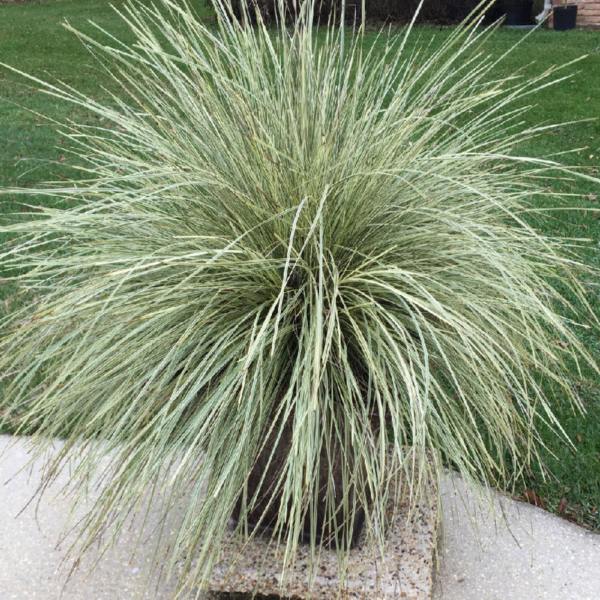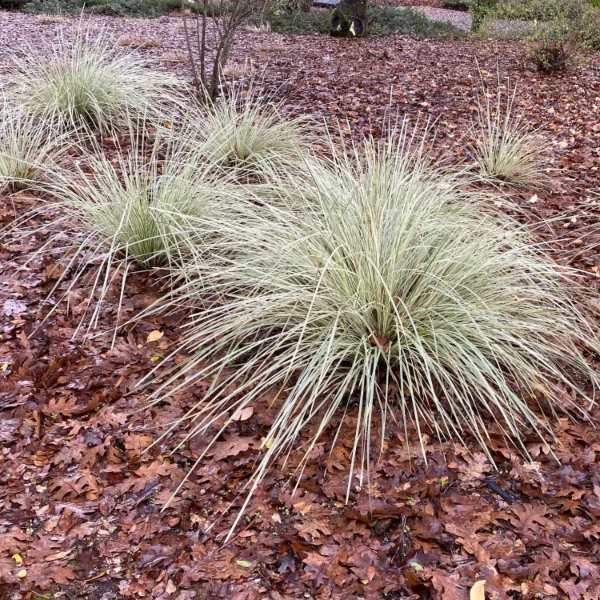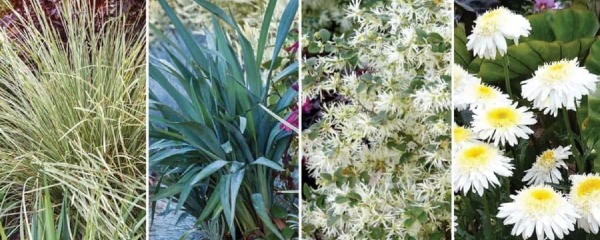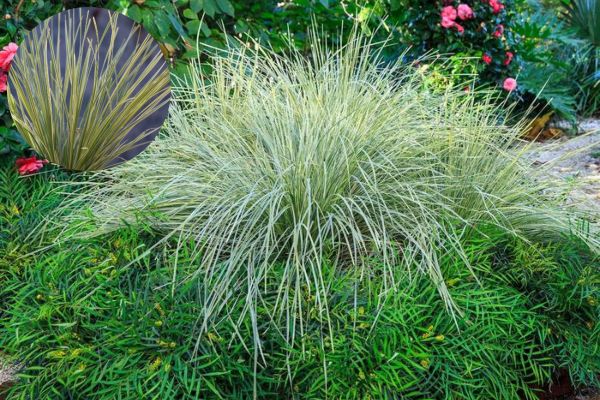Lomandra ‘Platinum Beauty’ is an evergreen perennial grass that is popular for its striking leaves that reach about 3 feet in height. The leaves are shiny with a glossy green color and include white stripes. The spikes of each clump are adorned with sharp, slender, straw-colored bracts, making for a dense, spike-like structure. Besides, this hardy perennial thrives in various conditions, making it an excellent choice for gardeners. Its drought-resistant nature and adaptability to different soil types, make it a reliable and attractive addition to any landscape.
In this article, we will look in detail at Lomandra Platinum Beauty, including its features, common name, companion plants, and how to grow and care for it.
Overview
Plant Type: Perennials
Season: Late winter, Early Spring
Family: Asparagacease
Common Name: Variegated Dwarf Mat Rush
Genus: Lomandra
Species: Lomandra longifolia
Native Area: Australia
What is the common name for Lomandra ‘Platinum Beauty’?

Lomandra Platinum Beauty is scientifically called Lomandra longifolia ‘Roma 13’, ‘White Sands’ PP25,962. However, its common name is Variegated Dwarf Mat Rush. This grass-like perennial belongs to the Asparagacease (Liliaceae) family which is originally from Australia. The name ‘Lomandra’ is derived from the Greek words “Loma”, which means “margin”, and ‘Andros’, which means “male”. Similarly, the specific word ‘longifolia’ means “long leaves”. Previously, the genus Lomandra was classified as Australian Grass Trees in the Xanthorrhoaceae or related Dasypogonaceae. Now it is included in its own family, the Lomandraceae, or the combined Cordyline in the Laxmanniaceae. It is further recognized as the Lomandroideae subfamily of the Asparagaceae.
Planting Lomandra Platinum Beauty
-
Best Time to Plant Lomandra Platinum Beauty
Lomandra Platinum Beauty plants should be planted in spring or fall. These seasons feature milder temperatures and more rainfall, which helps the roots grow strong. Planting in spring helps the Lomandra grow well because of the mild weather while fall planting lets the plant settle before winter, giving it a good start for the next spring.
Further, Lomandra is versatile and can be planted both in the ground and in containers, mixed in with border plantings, along walkways, or used as large-scale ground cover. It performs well on slopes, near coastal conditions, and in both sun and shade, as long as the soil has decent drainage.
-
Ideal Soil and Location for Lomandra Platinum Beauty
Lomandra Platinum Beauty thrives in full sun to moderate shade and also ensures the soil is well-drained. It does not like heavy moist soils and is cold-hardy just below 20° F. For optimal growth, you may use sandy or loamy soils, or improve heavy clay soils with compost or sand. Though Platinum Beauty loves both full sun and partial shade, try to avoid the harsh midday sun for its good health and healthier growth.

Lomandra Platinum Beauty Care
-
Spacing
Make sure that upon planting the Lomandra Platinum Beauty, you leave enough space for their proper growth. Usually, plant them about 4 to 5 feet apart. Spacing the plants while planting will give them the necessary room to spread out and flourish without becoming too crowded.
-
Watering Requirements
As previously stated, Lomandra Platinum Beauty is drought-tolerant. Nonetheless, it can also tolerate regular watering once it grows. After planting, make sure to give water the Lomandra regularly to keep it moist but not waterlogged. Regular watering provides the growing plant with the necessary moisture for good growth and health.
-
Fertilizing
It does not need frequent fertilizing. Apply a slow-release balanced fertilizer in spring and summer that provides all the nutrients necessary for good growth. Always water the plant thoroughly after fertilizing which will help the nutrients to penetrate the roots.
Ideal Companions for Lomandra Platinum Beauty
Companion planting means growing different plants together. This age-old gardening technique enhances the appearance of gardens and promotes plant health and productivity of yield. It also helps in keeping harmful insects away from the plants and attracting beneficial ones. In addition, it increases space utilization, especially if the garden is small. Here are some companion plants for Lomandra ‘Platinum Beauty’ that complement its texture, color, and growing conditions.
Myoporum
Myoporum parvifolium, also known as Creeping Boobialla, is a low-spreading plant that provides excellent ground cover. It has shiny leaves and pretty white flowers which complement Lomandra Platinum Beauty. Meanwhile, its hanging branches and star-shaped flowers look stunning next to Lomandra Platinum Beauty. Myoporum is very adaptable to various soils and flourishes in full sun to partial shade, making it an ideal companion for Lomandra Platinum Beauty in diverse garden settings.
Lily Pilly
Lily Pilly is a diverse group of evergreen trees and shrubs, native to Australia. This plant is known for its lush foliage, colorful new growth, and attractive berries. Lilly pilly shrubs or trees are very good as a background for Lomandra plants as their glossy foliage with vibrant new growth makes them stunning. Further, its height and density can add depth and variety to your garden landscape.

Aloe
Aloe has clusters of succulent, erect leaves that form a dense rosette while Lomandra has thin, grassy leaves. Though their characteristics differ, both plants can tolerate dry weather and prefer similar growing circumstances, so they work well together in gardens or landscapes. Additionally, the form of Aloe and its ease of maintenance make Lomandra Platinum Beauty’s upright growth more appealing
Callistemon (Bottlebrush)
Callistemon plants produce flowers that are bold in color and can brighten up the garden. Their distinctive bottlebrush-shaped blooms in shades of red, pink, or yellow provide a lively contrast to the green leaves of Lomandra. This plant further attracts bees and birds to their peculiar flowers, which enhance the view of the landscape. Moreover, Platinum Beauty and Callistemon both are low-maintenance and drought-tolerant, which makes them great companions in gardens.
Pennisetum (Fountain Grass)
Pennisetum, which is also native to Australia, stands out with its elegant leaves and fountain-like flowers, bringing texture and motion to the garden. Its soft flowers complement Lomandra’s sharp flower stems and flat leaves, enhancing the garden’s beauty. Furthermore, Pennisetum and Platinum Beauty are compatible companions in gardens or landscapes with similar growing conditions.
Nandina (Heavenly Bamboo)
Nandina, with its changing leaves and red berries, creates a beautiful contrast with the texture of Lomandra. Its red, purple, or bronze hues in colder months bring color to the landscape. Both plants prefer well-drained soil and sunlight, making them great companions in gardens. Additionally, Nandina provides a backdrop for Lomandra, offering contrast in color and texture to give an aesthetic look to the garden.
Also read, How to Grow and Care for Calathea Zebrina (Zebra Plant)!
Frequently Asked Questions
1. How big is Lomandra ‘Platinum Beauty’?
Lomandra ‘Platinum Beauty’ is an evergreen perennial grass that is popular for its striking leaves that reach about 3 feet in height.
2. How do you care for Lomandra ‘Platinum Beauty’?
Lomandra ‘Platinum Beauty’ thrives in full sun to moderate shade and also ensures the soil is well-drained. Make sure that upon planting the Lomandra Platinum Beauty, you leave enough space for their proper growth. After planting, give water the Lomandra regularly to keep it moist but not waterlogged.
3. Can Lomandra ‘Platinum Beauty’ be grown in containers?
Lomandra is versatile and can be planted both in the ground and in containers, mixed in with border plantings, along walkways, or used as large-scale ground cover.
4. What are the ideal companion plants for Lomandra ‘Platinum Beauty’?
The ideal companion plants for Lomandra ‘Platinum Beauty’ include, Callistermon (Bottlebrush), Pennisetum (Fountain Grass), Nandina (Heavenly Bamboo), and more.
5. Are companion plants for Lomandra Platinum Beauty low-maintenance?
Yes, many companion plants for Lomandra Platinum Beauty are low-maintenance and drought-tolerant, similar to Lomandra itself.
